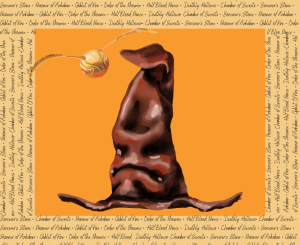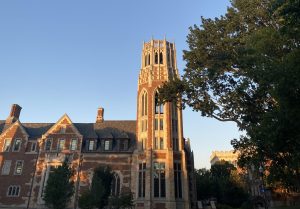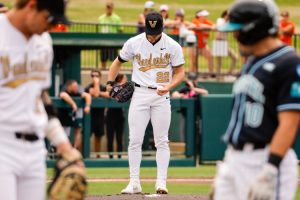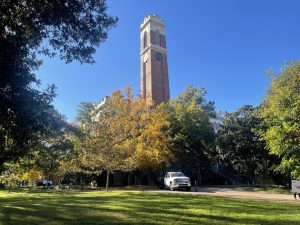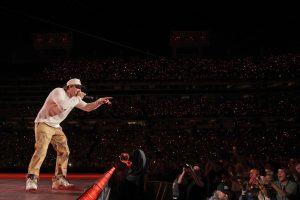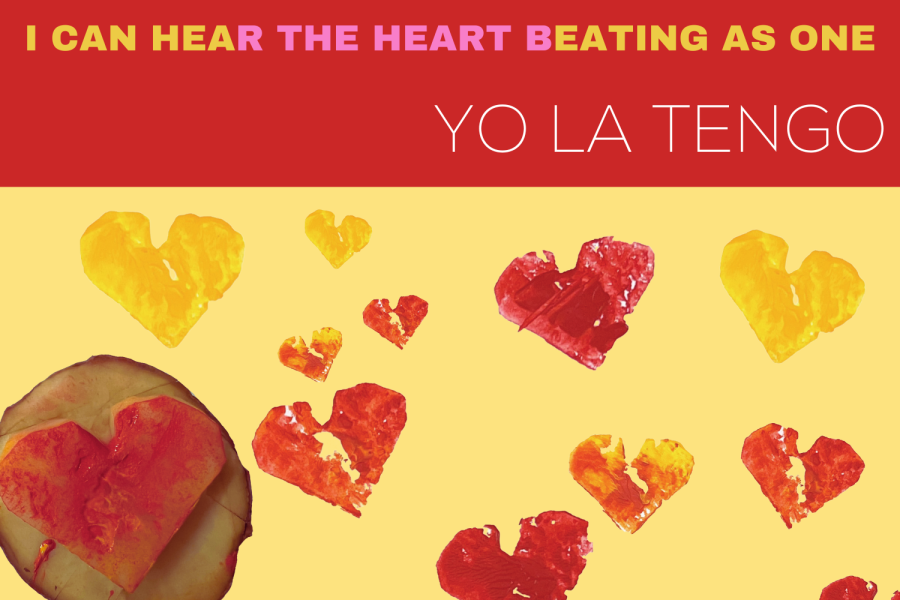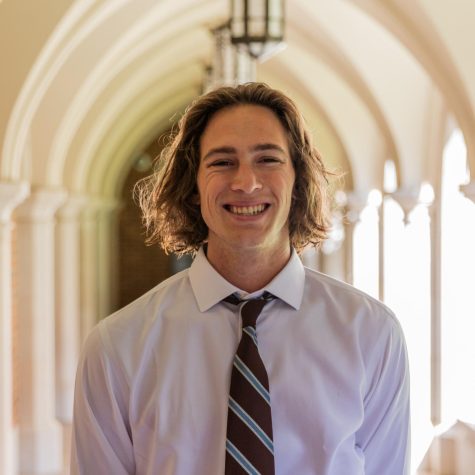The perfect album becomes an obsessive experience. It is listened to repeatedly in search of new details. It is played from the loudest volumes possible to the quietest ones, from dark rooms to packed houses. It accompanies you through various life events, no matter how large or small. The songs take on different meanings as you change as a person. The drum fills, basslines and guitar riffs become a part of you. You close your eyes, and the sounds engulf you.
For me, few albums hold the distinction of “perfect”—timeless and listenable across periods and backdrops. Yo La Tengo’s 1997 magnum opus, “I Can Hear The Heart Beating As One,” is one of the esteemed albums that is worthy of this adjective. Like many others (some who might not even realize it), I vividly remember discovering the album and the band, through “Gilmore Girls.” In 2020, when the first COVID-19 quarantine stretched into the fall months, I decided to binge the CW show. I watched the pilot episode, feeling comforted and warmed by the show’s homey feel. As the camera panned out from Luke’s Diner to the city of Stars Hollow, a beautifully harmonic cover of Anita Baker’s “My Little Corner Of The World” played. Immediately, I had to know what band it was.
After some digging, I found Yo La Tengo and “I Hear The Heart Beating As One.” As I lay in bed, listening to the album for the first time, I was transported—from the brooding noise rock of New York City to the twang of Nashville and the bustling soundscapes that could define any American city. Over the next few years, the record acted as comfort for me—through a pandemic, first loves and heartbreak, transitions to college and beyond. As I relisten to the collection of songs at each new stage of my life, the songs unravel themselves again as they gain a new layer of meaning. Despite predating almost everyone in my generation and the cultural artifacts we’ve come to associate with Gen Z (iPhones, social media, etc.), the album supersedes time and remains a significant work within Yo La Tengo’s expansive discography.
Yo La Tengo, an alternative rock group from Hoboken, New Jersey, was formed in 1984 by multi-instrumentalist Ira Kaplan and drummer-slash-vocalist Georgia Hubley. The duo, who is also married, tried out numerous bass players before finding James McNew in 1991. The band has worked to push boundaries across their almost 40-year career; they have made ambient EPs, soundtracked a documentary live in theater and created side projects dedicated to obscure covers, just to name just a few endeavors.
The “perfect” album should blend an artist’s past inspirations and indicate their future direction, morphing it into a new creation of its own. These works feel like well-curated playlists—jumping across styles and genres but sticking to a central theme. Yo La Tengo succeeds in doing this by combining influences of past artists like Sonic Youth and the Velvet Underground with foresight on electronic music and other diverse genres. “I Can Hear The Heart Beating As One” does just that, switching from shoegaze to Americana to cover songs and everything in between. Recorded in Nashville, the album is a dazzling testament to life at this time of year—akin to the cover’s bright orange hues melting into an image of New York City’s Holland Tunnel.
The Holland Tunnel, which connects Lower Manhattan to Jersey City, holds a special significance to Yo La Tengo and represents a certain life force for the group.
“They would pile up in their station wagon and drive into the city from Hoboken,” Mark Ohe, a former art director at Matador Records who handled art direction for the project, told me in a Zoom call. “They were always coming into Manhattan to do shows or come to the Matador office.”
Mark theorized that the recurring heart imagery throughout the album is symbolic of the relationship between Hoboken and New York.
“[The Holland Tunnel] is like some big major artery into the city. And then you’re talking about hearts and you’re talking [about] the whole idea of Manhattan being this life force with all these people and all this energy…,” Ohe explained. “But then you’ve got these main arteries coming in and out of the city.”
Ohe lauded the band as “pretty visual people,” describing that “they’re artists themselves in many different senses of the word.”
One of my favorite design details of the LP is its gatefold cover, where the band and Ohe created a litany of fictitious bands and album artwork that are revealed when the record is opened. The design displays a catalog of pretend Matador bands, mimicking the way old 1950s vinyl sleeves would advertise a record label’s upcoming releases. Much like the sound of “I Can Hear the Heart Beating As One,” the design of these fake records seems chaotic at first glance but are actually incredibly well thought-out. One specific example, Ohe’s favorite, is a fake Broadway musical entitled “Heroin!” For this cover, Ohe remembers drawing the letters by hand while the band gave pointers like “Tilt it more! Make the E bigger! Move the dot!” According to Ohe, the band worked for hours on the twelve album covers until they had perfected each one. To me, the gatefold reflects the esoteric and often hilarious shroud surrounding Yo La Tengo, exhibited through crazy side projects, absurd music videos and genre-bending musical outlets.
Most of the album was cut at the aforementioned historic House of David studio that remains in its original location on Music Row. Named for proprietor David Briggs, the studio was initially housed in an early 19th-century single-family home, where Briggs lived for some time. Briggs himself went through many distinct periods of his career, from being a session keyboardist at FAME Studios in Muscle Shoals to writing jingles and Whitney Houston hits. The storied building has held sessions for legends like B.B. King, Neil Young, Johnny Cash and Elvis Presley. It gained notoriety after installing a secret passageway with a trapdoor that was built to get Presley in and out of the studio without swaths of fans rushing him. Roger Moutenot, Yo La Tengo’s longtime producer, decided to move from New York to Nashville on recommendation from Roseanne Cash, taking his alternative catalog with him. For his first project, he brought John Cale, founding member of the Velvet Underground, down to record on Music Row.
“It [was] a little weird,” Moutenot said, “‘Cause we’re mixing this crazy John Cale tune… but it was a lot cheaper, and Nashville was a lot of fun.”
Yo La Tengo began working with Moutenot on their 1993 album “Painful.” The LP was recorded in Hoboken, before the band moved to Alex The Great Studios in Nashville to record their seventh album, “Electr-O-Pura.” It wasn’t until 1997 for “I Can Hear The Heart Beating As One” that they moved to the House of David. Yo La Tengo was one of the first alternative bands to record in the space in the late 90s. At the time, Nashville was characterized mainly by country acts. Moutenot cites the studio’s improved equipment and illustrious history as influential factors behind the record. Moutenot explained that each room of the historical house holds different parts of the studio, such as mixing and recording areas.
“I fell in love with the console. It was an API, a beautiful, old vintage API,” he said. “And it had a great tape machine and Studer and beautiful microphones. It was in the old house… the living room parlor is the live room and the dining room is another big thing.”
A sparse instrumental track named for one of Nashville’s best culinary offerings, the opening cut “Return to Hot Chicken” eases the listener into the expansive, genre-mixing offerings of “I Can Hear The Heart Beating As One.” On the short track, a repetitive bass line flourishes as Georgia Hubley and Ira Kaplan add fills on their respective instruments. At eight minutes long, the second song on the record “Moby Octopad” combines a jam band’s penchant for lengthy songs with Americana lap steel solos and a droning bassline. Renowned session player Al Perkins, who played on the track, described his lap steel solo as “short stabs” in an email to me, which fits perfectly within the fast-paced, staccato nature of the track. Frontman Ira Kaplan’s lush vocals contrast this effect—his voice reminiscent of the jazz trumpeter-slash-vocalist Chet Baker. This record represents Kaplan’s first venture into falsetto vocals, bringing a new addition to the abundance of sounds explored across its 68 minutes. The lead guitar, however, reflects a mainstay in Yo La Tengo’s sound—shoegaze—characterized by loud, discordant guitars and heavy effects pedals. Yo La Tengo’s earlier records are full of these tones, but “I Can Hear The Heart Beating As One” reflects a stylistic upheaval.
Although the album stays true to the band’s shoegaze roots, it also incorporates overdubbing and more extensive recording techniques, contrasting the live one-room takes of earlier projects like 1995’s “Electro Pura’s.” Despite conflicting reports online, Moutenot rebuffs that the album was recorded in an analog tape format. Moutenot mentioned a previous experience with ADAT recording (a digital format) and that it was a “one and done experience.”
“I’ll get that straight right now, it was a 24-track Studer,” he told me via Zoom.
These two recording elements, combined with Moutenout’s obsession with finding the perfect sound, contributed to a fuller, more expansive sounding record. Moutenot described that a constant barrage of changing mics and equipment was used to reflect the record’s stylistic differences. He said that as Kaplan’s guitar tone changed from soft to aggressive, his style of recording and mixing changed. If the song was calmer, Moutenot would use a condenser microphone to get a more direct sound from the guitar. On more driving songs, Moutenot would use a wide-range ribbon mic to capture the full energy of Kaplan’s tone.
They [Yo La Tengo] always pick out shit that’s a bit harder than they can play. They always push themselves in that way.
The iconic third track, “Sugarcube,” comes crashing in with a perfect mix of psychedelia and pop. The song opens with a drum fill from vocalist-slash-drummer Georgia Hubley before she sings about a failing relationship. Playing into the absurd aesthetics of the band itself, the song is backed by a hilarious music video featuring David Cross and Bob Odenkirk of the television series “Mr. Show.” The video depicts the band attending the “Pres. McKinley Academy of Rock,” where they play into the classic-rock trope, with “Gene Simmons” (Odenkirk) teaching a class on what it “truly” means to be a rock band, including teachings on Rush’s “A Farewell to Kings,” “The Theremin and You” and the best ways to trash a hotel room.
However, the entire album doesn’t fit the mold of lengthy shoegaze songs and catchy pop tunes—a few songs come out of left field. One pertinent example is “Little Honda,” a Beach Boys cover that upends the original surf rock tune and elevates it into a neo-psychedelia masterpiece. Another example, “My Little Corner of the World,” was initially written by Anita Bryant (an abhorrent symbol of my home state, Florida, and later Nashville, but I digress). Yo La Tengo turns the average 60s hit song into a perfectly lush and jangly version. This represents another tenet of Yo La Tengo’s sound—unexpected, esoteric covers.
Outside of covers, “I Can Hear The Heart” has been lauded for incorporating various genres into Yo La Tengo’s playbook. “Green Arrow” sets the groundwork for the band’s later ambient exploration. The track opens with crickets recorded just outside of House of David, the longstanding Nashville studio which hosted most of the album’s creation. Moutenot described the process behind the ambient intro.
“I took a break to get some air and these crickets were going crazy. The song was missing something, and the crickets were that natural thing to me,” he recalled.
On top of this groundwork, the band laid percussion and hypnotizing guitars. Moutenot loves adding these different kinds of flairs to songs, also mentioning a time he “recorded a bathroom fan and put it into a song.” Like “Green Arrow,” he said this atmospheric element tied the song together, adding a missing element (he wouldn’t remember what song he did this on but mentioned that it was on one of Yo La Tengo’s previous albums).
Another genre-bending song is the album’s thirteenth track, “Center of Gravity.” The song utilizes bossa nova guitars and shaker percussion to create a sweet ballad about the intoxicating effects of city love. It is one of my favorites off the record, for Hubley’s falsetto fits perfectly into the opening lines: “In crowded bars / past subway cars.” The lyrics make the mundane feel mystifying, before, in the track’s closing moments, words are abandoned for harmonizing hums reminiscent of jazz ballads of the past.
“Autumn Sweater,” what some consider the band’s unrivaled song, ties together the album’s fall theme and genre-mixing tendencies. The piece combines everything I love about Yo La Tengo—surging keyboards, a range of percussive instruments and impassioned lyricism. The song opens with four bars of kick drums before synths envelop the senses. Kaplan’s vocals kick in as he contrasts the warmth of a knit sweater to the cold, harsh energy surrounding a souring relationship. The entire song is punctuated by bongo drums played by Moutenot and, once again, shakers. Right after Kaplan repeats the chorus, the synths “braid together,” per Moutenot.
“That song was a bit of a beast,” he said. “They [Yo La Tengo] always pick out shit that’s a bit harder than they can play. They always push themselves in that way.”
In his typical style, Moutenot explained how he “scratched off some of the emulsion on the tape for the breakdown section. So you know, just kind of got fucked up…” This adds distortion to the part, rather than adding in effects afterward.
Regarding the staying power of the record, Mark Ohe reflected on the timeless energy surrounding the record. He views the 1997 record as “more popular than ever” and remembers how surreal it felt for Matador Records to notify him of its 25th-anniversary reissue.
“I read the whole email from top to bottom… I’m like, 25 years. I think that can’t be right. And went back and looked at that sentence again. I was like, 25 years. It’s incredible, ‘cause it doesn’t seem that long ago…it speaks to the quality and their timelessness,” Ohe said. “They had their own idea and stood apart in the test of time.”

